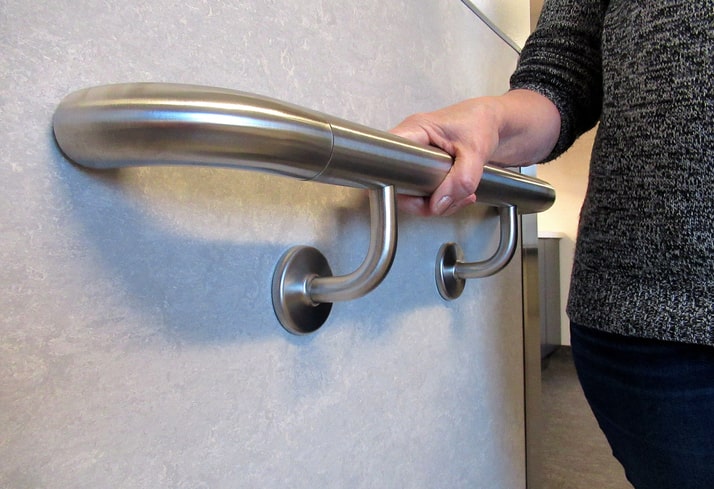Bathrooms, while essential, can pose significant hazards to seniors and individuals with mobility challenges. This makes understanding and implementing bathroom modifications crucial for caregivers. These changes not only enhance safety but also promote independence, allowing seniors to maintain dignity and privacy. In this guide, we’ll explore various modifications to transform bathrooms into safe havens.

Why Bathroom Modifications Are Essential
The confined space, hard surfaces, and presence of water make bathrooms potential danger zones. Falls, slips, and other accidents are common, particularly among seniors. According to the National Institute on Aging, over one-third of seniors experience falls each year, with the bathroom being a primary location. Implementing bathroom modifications is a proactive step in preventing falls and ensuring the well-being of those in your care.
Identifying Key Areas for Modification
Shower and Tub Safety
The shower and tub are particularly risky due to wet surfaces. Installing grab bars and non-slip mats are simple yet effective ways to enhance safety. Consider replacing bathtubs with walk-in showers to eliminate the need for stepping over high edges, which can be challenging for those with limited mobility.
Toilet Modifications
Adjusting the height of the toilet can make a significant difference. Elevated toilet seats reduce the need to bend down, making it easier for seniors to sit and stand. Additionally, installing grab bars beside the toilet offers extra support.
Lighting Improvements
Proper lighting is critical in preventing falls. Ensure that the bathroom is well-lit, with no dark corners. Motion-sensor lights are beneficial, automatically illuminating the space when someone enters. For more on how lighting affects safety, explore Preventing Falls with Better Lighting.
Choosing the Right Materials
When planning bathroom modifications, choosing the right materials is crucial. Opt for water-resistant and slip-resistant flooring. Materials like textured tiles or vinyl can help reduce the risk of slipping. Additionally, selecting easy-to-grip handles and faucets can aid those with arthritis or limited hand strength.
Incorporating Technology for Safety
Technology can play a vital role in enhancing bathroom safety. Consider installing a medical alert system within the bathroom. These systems allow seniors to call for help with the push of a button, providing peace of mind for both the individual and their caregivers. Smart home devices, such as voice-activated lights and temperature controls, can further aid those with limited mobility.
Consulting Professionals for Effective Modifications
While some modifications can be done independently, consulting with professionals ensures the changes are both safe and efficient. Occupational therapists can offer personalized advice based on the specific needs of the individual. Contractors specializing in senior home modifications can also provide valuable input on the best materials and designs.
Managing Costs and Budgeting
Cost is often a concern when considering bathroom modifications. However, there are ways to manage expenses effectively. Prioritize modifications based on immediate needs and safety concerns. Explore financial assistance options such as grants or insurance coverage for home modifications. Remember, investing in safety modifications can prevent costly accidents in the future.
Understanding Legal and Regulatory Requirements
When modifying a bathroom, it’s essential to adhere to local building codes and regulations. This ensures that the modifications are safe and meet legal standards. Consulting with professionals familiar with these requirements can help navigate this aspect of the modification process.
Encouraging Independence and Confidence
One of the primary goals of bathroom modifications is to encourage independence. By creating a safe environment, seniors can perform daily tasks with minimal assistance, boosting their confidence. The ability to use the bathroom independently can significantly enhance one’s quality of life, promoting a sense of autonomy and dignity.
Case Studies: Successful Bathroom Modifications
Many caregivers have successfully transformed bathrooms with strategic modifications. For instance, one family replaced a traditional bathtub with a walk-in shower, significantly reducing fall risks and improving accessibility for their loved one. Such examples highlight the impact of thoughtful design and planning.
Additional Resources
For further guidance, consider exploring resources such as Bathroom Safety for Stroke Survivors and Bathroom Safety for Parkinson’s Patients. These articles provide valuable insights into creating safer bathroom environments for individuals with specific needs.
Conclusion: The Path to a Safer Bathroom
Implementing bathroom modifications is a crucial step in caregiving, ensuring safety and promoting independence. By understanding the needs of those in your care and utilizing available resources, you can create a bathroom that is both functional and secure. Remember, a safer bathroom is a key component of a safer home.

FAQ Section
Q1: What are the most cost-effective bathroom modifications?
A1: Simple modifications like installing grab bars, non-slip mats, and improving lighting are cost-effective ways to enhance safety. Prioritizing these changes can significantly reduce fall risks without breaking the bank.
Q2: How can technology improve bathroom safety for seniors?
A2: Technology such as medical alert systems and smart home devices can enhance safety by providing easy access to help and enabling voice-activated controls, reducing the need for physical exertion.
Q3: Are there financial assistance options for bathroom modifications?
A3: Yes, there are various grants and insurance plans that may cover home modifications. It’s advisable to research available options and consult with professionals to understand eligibility and application processes.
This article contains affiliate links. We may earn a commission at no extra cost to you.

